Bees are an essential part of our ecosystem. In fact, the humble honeybee is the world’s most important pollinator of food crops. Without these super pollinators buzzing around, humanity’s chances of survival could be drastically compromised.
Now that’s a worrying thought, right?
But while we can all agree that bees should be protected, not everyone wants a hive of bees as tenants or roommates on their property. And that’s OK!
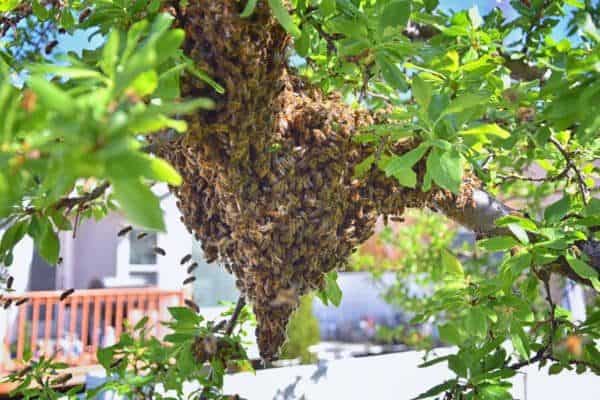
Luckily, it’s possible to safely remove a population of honeybees, without turning to an exterminator. And this guide will show you how.
Identify Whether You Are Dealing With A Swarm Or An Established Hive
When you spot a large group of honey bees, you could be looking at either a hive or a swarm.
It is important to understand the difference between the two, as bees behave differently depending on whether they have an active hive to protect. Therefore, the method for removing hives and swarms will also differ.
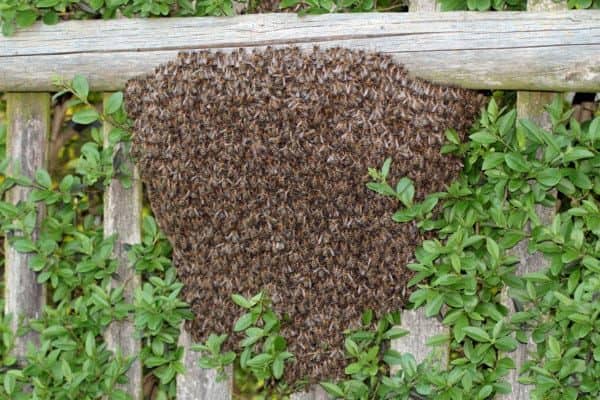
You see, bees behave differently depending on whether they have an active hive to protect, and methods for removing hives and swarms can have some differences.
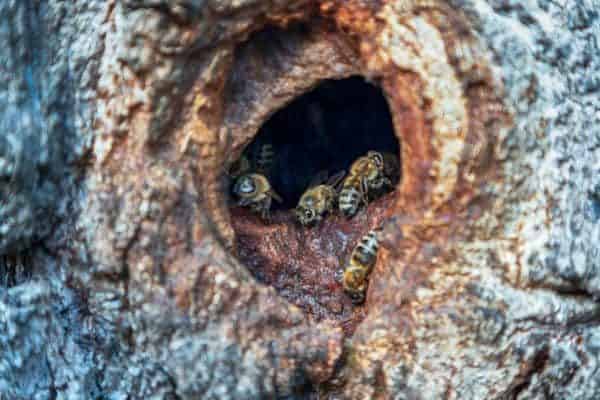
So, What Exactly Is The Difference?
Well, a hive is an established colony of honey bees, composed of a queen bee, workers, and drones, all living in an enclosed home where they raise their young and create the honey that lends them their name.
A swarm on the other hand is a collection of ”homeless bees” in search of a new hive. You see, as a colony of bees grows, hives can become rather crowded and uncomfortable.
When this happens, a new queen bee is selected and the existing monarch leaves her hive with around a third of her subjects. This newly formed colony travels in a tight ball in search of a suitable place to build a new home.
While one might think the difference between a hive and swarm would be obvious to spot, it’s not always that easy – especially if your bees are high up or appearing through cracks in the wall!
Luckily, there are some questions you can ask to help puzzle it out:
How Long Have The Bees Been On Your Property?
The first step in identifying the type of bee colony whether you have a swarm or a hive is to ask yourself how long your bees have been in residence? If your new housemates have been in your home for less than 1 week, you can rest assured you are dealing with a swarm.
If they have been there longer than a week you may be housing a newly established hive.
Can You See The Colony?
The next question you need to ask yourself is, can you see the colony? If bees are sneaking trickling into your home through cracks and crevices, you may need to do a little investigative job to locate and search out the source.
Where Are They?
Despite what you might have seen in cartoons, honeybee hives are rarely found hanging from trees, as they prefer more sheltered spots. In fact, while beekeepers tend to keep their bees in wooden homes, natural hives are often built into pre-existing cavities like the hollow of a tree or a chimney breast.
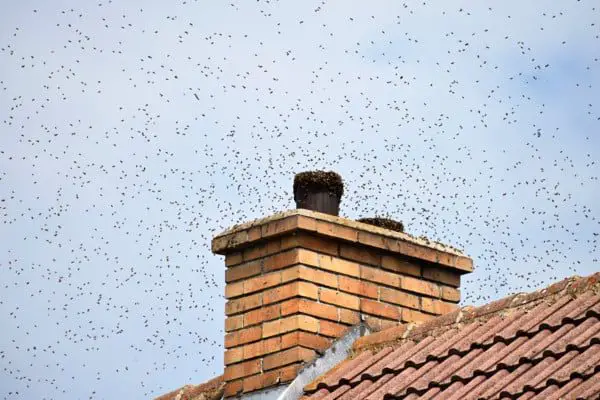
So, if your bees are hanging around in an exposed place, it is likely to be a swarm waiting for scout bees to return with intel on potential places to lay down roots.
Can You See A Structure?
So you know where the bee colony is? Great! Can you see an obvious structure? Honeybees make their nests from interlocking hexagons cells made out of ‘comb’ (a type of wax). You may be able to spot these telltale yellowish structures by peering into the cavity where your bees have settled.
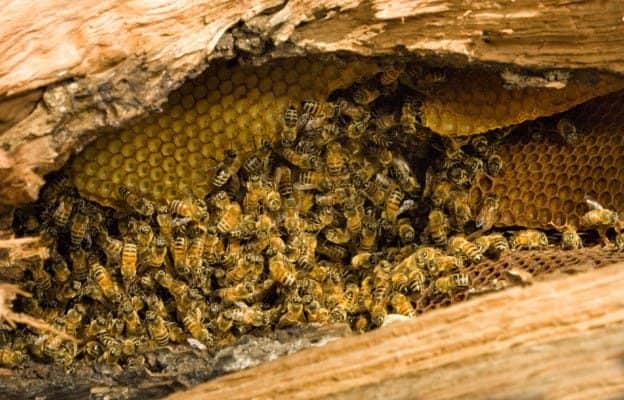
If you’re sure that there is no structure, you’re likely to be dealing with a swarm.
Are Your Bees In A Ball Or An Oblong Formation?
But what if you can’t see whether there is a structure underneath those busy bees?
Sometimes it can be difficult to see whether bees are crawling over their combs, or simply are nestled in close together. Especially when they choose a sheltered, difficult-to-access spot.
But even if you can’t see close enough to identify a structure, you can make an educated guess based on the formation of the bees.
Now it’s not an exact science, but swarms tend to be tight, dark, and oblong in shape. Hives, on the other hand, can appear less tightly packed and are more of a round shape.
Still not sure if you’re dealing with a hive or a swarm? Don’t worry! It can be difficult to tell.
So, what should you do next? Let’s take a look:
Call A Local Beekeeper
If you have identified an established hive, or you’re not sure exactly what you’re dealing with, the best course of action is to call in an expert.
Now, don’t jump straight to calling an exterminator. Call your local experienced beekeeper instead. Beekeepers are an excellent source of wisdom when it comes to honeybees and they may even be happy to remove the bee colony for you.
After all, bees are expensive to buy and many keepers are happy to take a gamble on a new swarm. Some actually prefer to source local bees as they are familiar with their local plant species, and this avoids transporting colonies across great distances to restock their hives.
So, Do You Have To Pay For A Local Beekeeper To Come Out?
Honestly? It depends.
Some beekeeper associations offer a free bee removal service, though the availability of these services varies considerably between countries and areas.
If you are lucky and your bees are not difficult to collect, you may be able to find a local hobbyist who is interested in taking your bumbling friends for free.
However, many beekeepers do charge for their services. Removing a bee colony can take a lot of time and effort and there is no guarantee that a wild swarm will prove to be a good honey producer.
Where Can I Find Beekeepers Near Me?
Try searching online for local beekeeper associations that may be able to point you in the direction of a helpful bee lover. Alternatively, you can also often find groups dedicated to beekeeping on social media.
Find An Ethical Pest Control Company
OK, so when you hear the term ‘pest control’ you probably think about your mind instantly going to harmful chemicals and extermination, right?
Well, fortunately, this isn’t always the case.
In fact, there are plenty of pest control professionals who are highly experienced in harm-free bee removal services.
How Do Beekeepers Or Pest Controllers Ethically Remove Bees?
When it comes to harm-free bee removal, there are two methods commonly used by pest control professionals:
Cut-out Removal
The quickest way for professionals to remove honey bees is called ‘cut-out’ removal. This method involves using a special vacuum to collect a colony’s bees from their hive. The bees are then stored in a vac box. Their ‘brood’, including the larvae and young carer bees, are then placed into a smaller ‘nuc’ box until they can be reunited in a suitable location.
Once the bees have been successfully removed, care is taken to remove all traces of the honeycomb to reduce the risk of future infestations.
This whole process can take anything from a couple of hours to a full day to carry out.
Trap-out Removal
Like the cut-out method, trap-out removal aims to move a beehive without causing harm to its residents. However, this process is a little more challenging and time-consuming. It involves sealing all but one entrance to an active hive. Bees are then slowly collected into a ‘nuc’ box as they leave the hive.
Even though a much better option than using poison, this method does have some downsides. Not only does it take weeks to fully empty the hive, but it is common for broods to die during the process.
So now you know that calling a bee expert is an effective option to get rid of a hive or a swarm.
But what if you are sure you’re dealing with a swarm and want to remove it yourself? Well, calling a local beekeeper or an ethical pest control operative are still fantastic options, but there are some useful other methods you can try.:
Invest in a swarm box
If you are confident around bees, you can try removing the swarm by yourself using a swarm box. Swarm box is basically an inviting home attractive to wild homeless bees who are “house hunting.”
Even though popular among beekeepers, a swarm box is not always the cheapest or the easiest method for a newbie. For starters, you will need to source some protective clothing. Swarming bees are less inclined to sting but they will still attack to protect themselves when needed. And you’ll need some other equipment, like a suitable box and lemongrass oil in your bee removal arsenal.
To understand how a swarm box is used, check out this Youtube tutorial by Bee Built:
Once you have successfully collected your swarm you can release them in a suitable location away from your property.
How To Beeproof Your Home
Sometimes it is not necessary to remove a swarm of bees at all. If you can make your home look unappealing to a bee colony, it is likely that they will simply rest and move on.
So, how can you reduce the risk of a swarm setting up a permanent home on your property?
Well, bees need three things in order to thrive:
● Food in the form of nectar from flowers
● Water
● Shelter
But, since bees are such an important part of our eco structure, most people are happy for bees to visit their yards. And that means keeping a good supply of flowers and allowing access to water.
Don’t worry though! You can still keep a bee-friendly garden without inviting any permanent house guests. You simply need to concentrate on removing potential places for bees to shelter.
To achieve do this, you’ll need a sharp eye. Bees can squeeze their way into openings as small as 3/16-inch in diameter in their search for a suitable cavity.
So what do we suggest?
Check For Holes And Cracks In And Around Your Property
Take a look around your property. Are there any openings that a bee might take notice of? Be sure to consider:
● Cracks in your walls and around window frames
● Open chimney breasts
● Spaces under your porch
● Unused plant pots
● Cavities in trees
● And gaps in sheds or outbuildings
Once you have located potential openings, take steps to block them off. This could include adding a screen to your chimney or filling in cracks with a suitable sealant.
After you have finished bee-proofing, it is worth keeping an eye on your swarm. Chances are they will move on quite quickly. However, if you notice the swarm getting gradually smaller it is possible they have beaten your defenses and made their way into a cavity you missed. In this case, it may be time to call in an expert.
Now we’ve looked at some of the methods used to remove honey bees from your property, it’s also good for you to know what you shouldn’t do?
Let’s take a look:
What Not To Do If You See Bees Around Your Home
Though it can be tempting to do whatever it takes to get rid of unwanted insects, especially if they have made their way inside your home, it pays to be careful.
Now when it comes to bees, there are some things you should definitely avoid:
Don’t Agitate The Bees
Bees don’t necessarily generally want to sting you… but this doesn’t mean that they won’t defend themselves.
That being said, it is important that you don’t try to scare a colony of bees off your property by throwing things at them, squirting them with water, or anything else that is likely to make them feel under attack.
Don’t Use Poison (even if it is legal in your location)
Obviously, we don’t want you to kill bees (we do love them after all!). But even if you don’t care for bees that much at all, using poison is just a bad choice.
You see, there are two major issues with the use of poison: Poisoned bees can be eaten by predators like birds. This can, unfortunately, lead to secondary poisoning which may prove fatal.
Dead bees can cause a stink. Think about it, the majority of the bees you poison are going to die in and around their home. Now if this home is a cavity in your wall, underneath your floorboards, or somewhere equally difficult to access, you are going to struggle to remove all of the carcasses.
Now I’m going to level with you:
Piles of rotting bees smell bad. Like really bad.
And that means it’s much better for both the bees and your sense of smell to remove them alive!
Important Things To Remember
When dealing with an unwanted bee infestation, it is important to remember that bees are mostly harmless.
While it is true that honey bees can sting, they are unlikely to do so without provocation. So, please try not to worry if you can’t have them removed immediately.
It is also worth remembering that honey bees are a legally protected species in many places. Well, we did say they were important to the environment!
Now, exact laws vary by country and state, but in some places, there are rules on how bees should be treated. In order to protect yourself, it is important to research local laws and use a professional service if in any doubt about the legalities.
Hopefully, you are feeling more in control of your bee squatters problem now. But just to make sure, let’s do a quick recap:
The Wrap Up
Bees are brilliant, but that doesn’t mean they are always good houseguests. So, to remove unwanted bees, you should first determine whether you have a hive or a swarm.
Then to remove the problem, you could:
● Contact local beekeepers
● Employ an ethical pest control operative
● Catch the bees yourself in a swarm box
● Or bee proof your home before they set up permanent residence
While it’s important to remember that bees are unlikely to sting unless provoked, it is still a good idea to treat them with respect. And try to avoid poisoning bee colonies (unless you want your home to reek or smell!).
Good luck!
